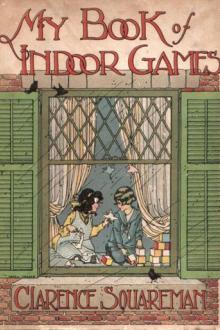My Book of Indoor Games by Clarence Squareman (top novels to read .txt) 📖

- Author: Clarence Squareman
- Performer: -
Book online «My Book of Indoor Games by Clarence Squareman (top novels to read .txt) 📖». Author Clarence Squareman
Two persons go out of the room, and after agreeing together as to what they shall represent, they come back again, and sit side by side in front of the company. One of the two takes the part of some well-known person, and the other represents an object which is closely connected with that person; for instance, say one represents the governor, and the other the mayor. When the two return to the room, the other players take it in turns to ask each of them a question, to which both the man and the object must reply either "Yes" or "No," until the right person and the right object have been guessed.
The first player will perhaps ask the "man:" "Are you alive?"
The man will reply, "Yes;" then the object is asked: "Are you of wood?" "No." The second player next questions him, and then the third, and so on until every one has had a turn at questioning, or the person and the object have been guessed.
The Jolly MillerThe players decide among themselves which one of their number shall act the part of the Jolly Miller. This being done, each little boy chooses a little girl as partner; the Jolly Miller having taken his stand in the middle of the room, they all commence to walk arm-in-arm round him, singing the following lines:
There was a jolly miller who lived by himself;
As the wheel went round he made his wealth;
One hand in the hopper, and the other on the bag;
As the wheel went round he made his grab.
At the word "Grab" all must change partners, and while the change is going on the miller has the opportunity given him of securing a partner for himself. Should he succeed in doing so, the one left without a partner must take the place of the Jolly Miller, and must occupy the center of the room until fortunate enough to get another partner.
Ruth and JacobOne player is blindfolded, the rest dance in a circle round him till he points at one of them. This person then enters the ring, and when the blindman calls out "Ruth," answers "Jacob," and moves about within the circle so as to avoid being caught by the blindman, and continues to answer "Jacob," as often as the blindman calls out "Ruth." This continues until "Ruth" is caught. "Jacob" must then guess who it is he has caught; if he guesses correctly, "Ruth" takes his place, and the game goes on; if he guesses wrongly, he continues to be "Jacob."
CheckersThis is a splendid game and one very easily learned. It is played upon a special board with thirty-two white and thirty-two black squares.
Two persons play at the game, who sit opposite to each other. The players have each a set of twelve pieces, or "men," the color of the sets being different, so that the players can distinguish their own men easily. The men are round and flat, and are usually made of boxwood or ebony and ivory, one set being white and the other black.
Before placing the men upon the board, it must be decided whether the white or the black squares are to be played on, as the whole must be put on one color only. If the white squares are selected, there must be a black square in the right-hand corner; if the black squares are to be played upon, then the right-hand corner square must be a white one.
The movements in checkers are very simple; a man can be moved only one square at a time, except as explained hereafter, and that diagonally, never straight forward or sideways. If an opponent's man stand in the way, no move can take place unless there be a vacant square beyond it, into which the man can be lifted. In this case the man leaped over is "taken" and removed from the board.
The great object of the game, then, is to clear the board of the opponent's men, or to hem them in in such a way that they cannot be moved, whichever player hems in the opponent or clears the board first gains the victory. As no man can be moved more than one step diagonally at a time (except when taking opponent's pieces), there can be no taking until the two parties come to close quarters; therefore, the pushing of the men continuously into each other's ground is the principle of the game.
In beginning the game, a great advantage can be obtained by having the first move; the rule, therefore, is, if several games are played, that the first move be taken alternately by the players.
When either of the players has, with his men, reached the extreme row of squares on the opposite side (the first row of his opponent), those men are entitled to be crowned, which is done by placing on the top of each another man, which may be selected from the men already removed from the board. The men so crowned are called "Kings" and have a new power of movement, as the player may now move them either backward or forward, as he wills, but always diagonally as before.
The Kings having this double power of movement, it is an important point for a player to get as many men crowned as possible. If each player should be fortunate enough to get two or three Kings, the game becomes very exciting. Immediately after crowning, it is well for a player to start blocking up his opponent's men, so as to allow more freedom for his own pieces, and thus prepare for winning the game.
It is the rule that if a player touch one of his men he must play it. If player A omit to take a man when it is in his power to do so, his opponent B can huff him; that is, take the man of the player A off the board. If it is to B's advantage, he may insist on his own man being taken, which is called a "blow." The usual way is to take the man of the player A who made the omission, and who was huffed, off the board.
It is not considered right or fair for any one watching the game to advise what move to be made, or for a player to wait longer than five minutes between each move.
Great care should be taken in moving the men, as one false move may at any time endanger the whole game.
With constant practice any one can soon become a very fair player, but even after the game has been played only a few times it will be found very interesting.
DominoesThere are several ways of playing Dominoes, but the following game is the most simple:
The dominoes are placed on the table, face downward, and each player takes up one, to decide who is to play first. The one who draws the stone with the highest number of pips on it takes the lead. The two stones are then put back among the rest; the dominoes are then shuffled, face downward, and the players choose seven stones each, placing them upright on the table, so that each can see his own stones, without being able to overlook those of his opponent.
As there are twenty-eight stones in an ordinary set, there will still be fourteen left from which to draw.
The player who has won the lead now places a stone, face upward, on the table. Suppose it be double-six, the other player is bound to put down a stone on which six appears, placing the six next to the double-six. Perhaps he may put six-four; the first player then puts six-five, placing his six against the opposite six of the double-six; the second follows with five-four, placing his five against the five already on the table; thus, you see, the players are bound to put down a stone which corresponds at one end with one of the end numbers of those already played. Whenever a player has no corresponding number he must draw from the fourteen that were left out for that purpose. If, when twelve of these fourteen stones are used up, he cannot play, he loses his turn, and his opponent plays instead of him. The two remaining dominoes must not be drawn.
When one of the players has used up all his dominoes, his opponent turns up those he has left, the pips are then counted, and the number of pips is scored to the account of the player who was out first.
If neither player can play, the stones are turned face upward on the table, and the one who has the smallest number of pips scores as follows: If the pips of one player count ten and those of the other player five, the five is deducted from the ten, leaving five to be scored by the player whose pips only counted five.
The dominoes are shuffled again, the second player this time taking the lead, and the game proceeds in this way until one or other has scored a hundred, the first to do so winning the game.
This game is generally played by two only, though it is possible for four, five, or even six to join in it; but, in that case, they cannot, of course, take seven stones each, so they must divide the stones equally between them, leaving a few to draw from, if they prefer it; if not they can divide them all.
Green GravelIn this game the children join hands and walk round in a circle, singing the following words:
Green gravel, green gravel, your grass is so green,
The fairest young damsel that ever was seen.
I'll wash you in new milk and dress you in silk,
And write down your name with a gold pen and ink.
Oh! (Mary) Oh! (Mary) your true love is dead;
He's sent you a letter to turn round your head.
When the players arrive at that part of the song, "Oh, Mary!" they name some member of the company; when the song is finished, the one named must turn right round and face the outside of the ring, having her back to all the other players. She then joins hands in this position and the game continues as before until all the players face outward. They then recommence, until they all face the inside of the ring as at first.
Fives and ThreesThis is another game that is played with dominoes, and is one of the most popular. It is excellent practice for counting, and to be successful at it depends, in a very great measure, upon skill in doing this. Two, three or four players may take part in this game. After the dominoes have been shuffled, face downward, each player takes an equal number of stones, leaving always three, at least, upon the table; no player, however, may take more than seven, and it is perhaps better to limit the number to five.
In playing dominoes, it should always be borne in mind that one end of the domino to be played must always agree in number with the end of the domino it is to be placed against.
The object of the game is to make as many "fives" and "threes" as are possible; for instance,





Comments (0)